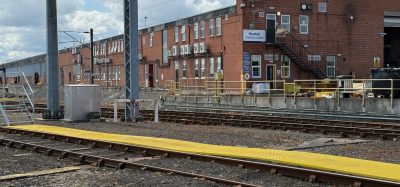Is rail ready for transformation?
Posted: 20 December 2022 | Dassault Systèmes, Global Railway Review | No comments yet
In an interview for Global Railway Review, Taherah Kuhl, Vice President Business Services at Dassault Systèmes, talks about the challenges and opportunities for the transformation of rail, and asks: are we ready for it?


The railway industry is facing a combination of new and existing challenges as it navigates its way to become a more modern mode of transport. Increased demand, the evolving requirements of the ‘digital’ passenger, the need for more capacity, a modal shift to rail, and more efficient and effective asset management; these are all priorities every corner of the industry must focus on to ensure future success.
The future of rail and its evolution is very much at the forefront of the work and the decisions of Dassault Systèmes – a science-based company. Deep sciences are the proven foundation to build a better future providing unparalleled, sustainable virtual twin experiences for businesses and people. Dassault Systèmes achieves this through a combined model‑based, data-driven, multi-physics approach across a broad set of industries including transportation, aerospace, consumer products and life sciences.
“Rail must go through a period of transformation,” says Taherah. “The modal shift that we’re seeing right across the globe – from air to rail, from road to rail, from sea to rail – and the drive for sustainability, is all linked with rail’s transformation.”
But Taherah has a strong question for the industry – and one that she delivered to the audience at Global Railway Review’s Digital Rail conference at London’s Twickenham Stadium in November 2022: is rail truly ready for transformation?
The shift to rail
Meeting net zero targets are of major importance right now for everyone and, without question, rail is the most environmentally efficient by gross tonnes per kilometre.
In efforts to reach climate neutrality by 2050, the shift to rail is gaining momentum, and railways are on an important journey to a cleaner, greener future. Throughout the world, rail transport is recognised as one of the most environmentally friendly forms of transport, with greenhouse gas (GHG) emissions per passenger kilometre for rail transport up to five times less than that of car transport. But how does the theme of sustainability, and the ongoing need for a greener future, fit into rail’s transformation?
“Sustainability is at the core of the move from other forms of transport to rail,” explains Taherah. “Meeting net zero targets are of major importance right now for everyone and, without question, rail is the most environmentally efficient by gross tonnes per kilometre. Rail freight emits 95 per cent less emissions than air travel for the same load and distance, and land-bridging by rail instead of sea reduces non-CO2 emissions by 84 per cent.”
Another key factor in driving the resurgence of rail-based transport and advocating the shift to rail is that of modal congestion. Taherah explained that to reduce road congestion, the European Commission (EC) mandates a modal shift for freight from road to rail of 30 per cent by 2030 and 50 per cent by 2050. And for air, Taherah explained that since 1 March 2022, France has banned internal flights of less than two hours where an equivalent fast rail service exists, and China has ceased adding internal aviation services in favour of high‑speed rail services.
“Transporting 52 trucks by road is the equivalent of transporting just two carriages by rail,” explained Taherah. “There is also the ongoing issue of truck driver shortages, so all these factors add up and make the case for a modal shift to rail even more appealing.”
The huge amounts of investment into rail across the global are also helping with rail’s transformation. For example, India’s National Logistics Policy will mean rail infrastructure investments for the country of over US$ 715 billion by 2030, there are new rail investments in Australia exceeding AUD$ 100 billion, and New Zealand is investing over US$ 1.2 billion in its rail infrastructure.
“But all is not rosy,” said Taherah. “The route to transformation will not be easy.”
Barriers to transformation
There is now suddenly a huge drive towards really digitalising the rail industry, so we must bring people onboard to make that journey together and to really understand the benefits and the values that digitalisation can bring.
Although rail is a long-established mode of transport, there was a period where development stopped, and technology wasn’t utilised. But now the industry is adapting to change and applying technical advances, some would argue that working practices have not kept pace with those modern changes, making it difficult for the industry to innovate effectively.
“I think one of the barriers to innovation is people,” explained Taherah. “There is now suddenly a huge drive towards really digitalising the rail industry, so we must bring people onboard to make that journey together and to really understand the benefits and the values that digitalisation can bring.”
Taherah was also keen to point out the issues around the globe with rail worker strikes and the effect this has on moving rail progress forward. “It isn’t always about salary and money. Work-life balance is also important for rail’s workforce – whether that’s about fair structures within organisations, or meeting workforce regulations. Take the United States for example, pay increases were recently secured, but negotiations now go beyond salary and the focus is better work-life balance and more structured oragnisational practices. At Dassault Systèmes, we help a lot of companies manage their crew/workforce preferences – it is a complex issue but making sure the right people are in the right place, at the right time and with the right qualifications, is important for improvement.”
LEARN MORE
In a video interview with Global Railway Review at Digital Rail 2022, Taherah Kuhl, Vice President Business Services at Dassault Systèmes explained more about rail’s period of digital transformation and Dassault Systèmes’ top priorities for driving forward progress. Take a look at the video here.
Making rail more attractive
We’ve seen organisations face difficulties when trying to rapidly assess and provide a coordinated response to unplanned disruptions, and – in many cases – this is down to rail companies working with siloed systems. This siloed approach won’t work in short-term planning situations.
The modal shift to rail can only happen if rail is more attractive, and to make rail more attractive, the industry must assess if it has the right infrastructure and capacity in place. Taherah commented: “If the right infrastructure isn’t already in place, then the industry can only work with what it already has. Rail companies need to optimise their operations – whether that’s optimising service excellence, minimising overall transit times, or controlling costs.”
Dassault Systèmes has created a ‘Business Capability Map’ which helps rail companies (both passenger and freight) in their planning, scheduling, and operations activity. The Business Capability Map is divided into different segments – ‘Above Rail’, ‘Below Rail’, and ‘Off Network’. Within each of those segments there are different functions such as fleets, crews, infrastructures, terminals, and a ‘time horizon’ including ‘tactical’, ‘pre-operative’ and ‘operational’ approaches. Rail companies can use the tool to map out the gaps in their activities and identify which areas need improving.
“We use this as a diagnostics tool,” explains Taherah. “Working directly with our clients helps us to understand what challenges they have. We’ve seen organisations face difficulties when trying to rapidly assess and provide a coordinated response to unplanned disruptions, and – in many cases – this is down to rail companies working with siloed systems. This siloed approach won’t work in short-term planning situations. The ability to react quickly – with an integrated approach – is necessary to make rail networks more attractive.”
End-to-end solutions
Rail yards can often create a ‘black hole’ for operatives, where they don’t have that end-to-end view of what’s going on, and that absolutely needs to change.
Rail yards play an important role in the overall value chain of passenger and freight transportation; they are a complicated series of rail tracks acting as hubs for operations including the inspection and repairing of wagons, sorting of rolling stock and fueling activity. But Taherah explained that yard planning often presents challenges. “The main areas for improving the planning and scheduling in rail yards are configuration, occupation, and shunting planning. We carried out research recently which showed that in one particular country, approximately 80 per cent of its rail network disruptions were due to trains moving from yards onto the main lines late, creating a huge bottleneck. Rail yards can often create a ‘black hole’ for operatives, where they don’t have that end-to-end view of what’s going on, and that absolutely needs to change.”
Rail network sharing – often a complex activity – is something that Taherah also sees opportunity for improvement. “Multiple parties can often be involved with network sharing, with the rail-based supply chains all trying to share the same assets while achieving an equitable outcome. We think it is important that a business/organisational approach is established first, before technical solutions. This ensures equitable access for all operators over the network and that fair access is given. Only then should a solution be created.”
Opportunities and priorities
…if rail is not operationally efficient, then the whole shift to rail is just not going to happen, and this is really important to Dassault Systèmes and our clients.
Learning from other industries and taking best practice advice is something that Taherah values highly. “Leveraging technology and seeing how it has transformed other industries can really help the rail industry move forward. Virtual twins – or digital twins – provides huge opportunity and help to capture and improve that end-to-end activity of rail. Whether it is applied to rail yards, main line rail tracks, or to the rolling stock, digital twins can collect data and provide us with analytics – the information that’s needed for more efficient maintenance and rail management. This, together with collaboration across the industry between customers and clients is very important to drive transformation; because ultimately, if rail is not operationally efficient, then the whole shift to rail is just not going to happen, and this is really important to Dassault Systèmes and our clients.”


Issue
Related topics
Cargo, Freight & Heavy-Haul, Digital Twins, Digitalisation, Technology & Software, The Workforce








